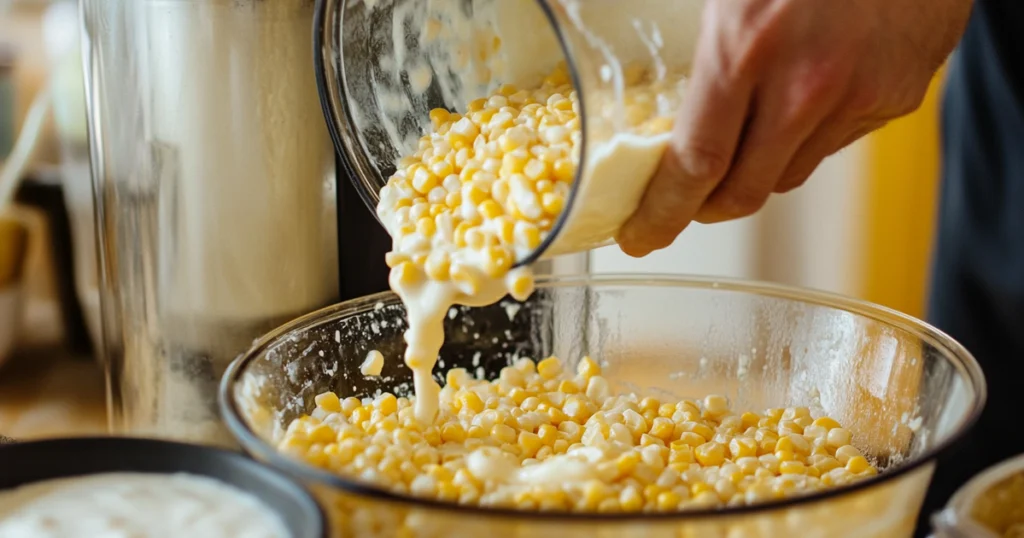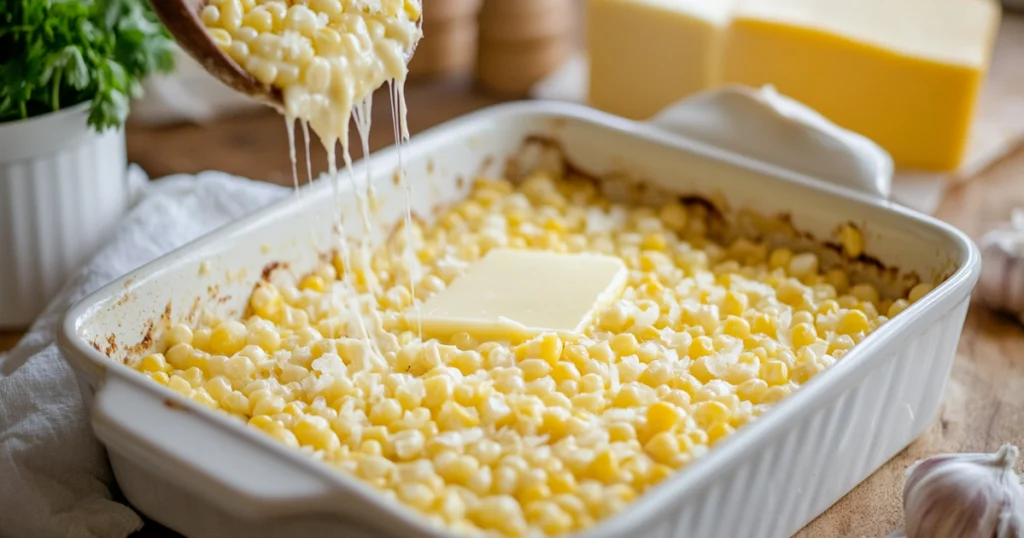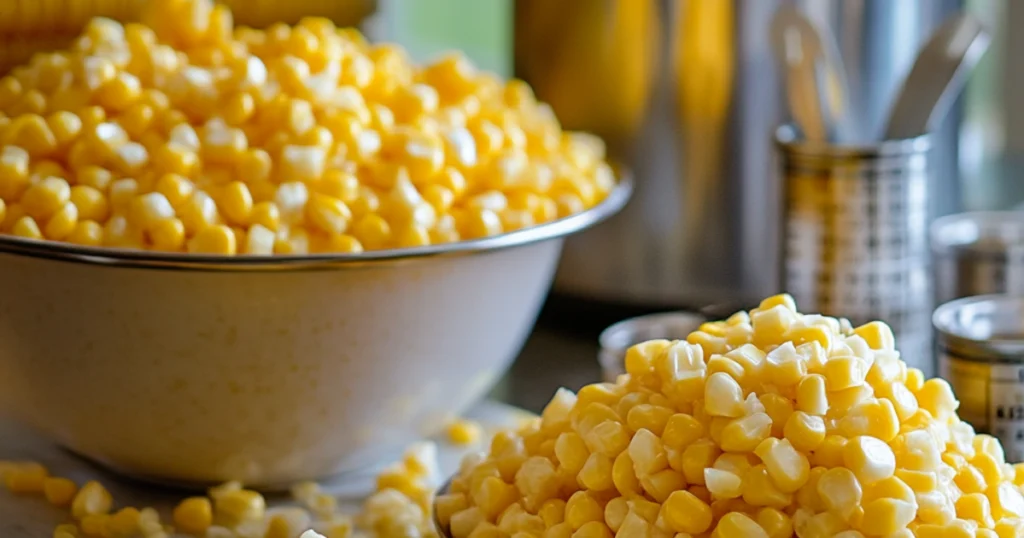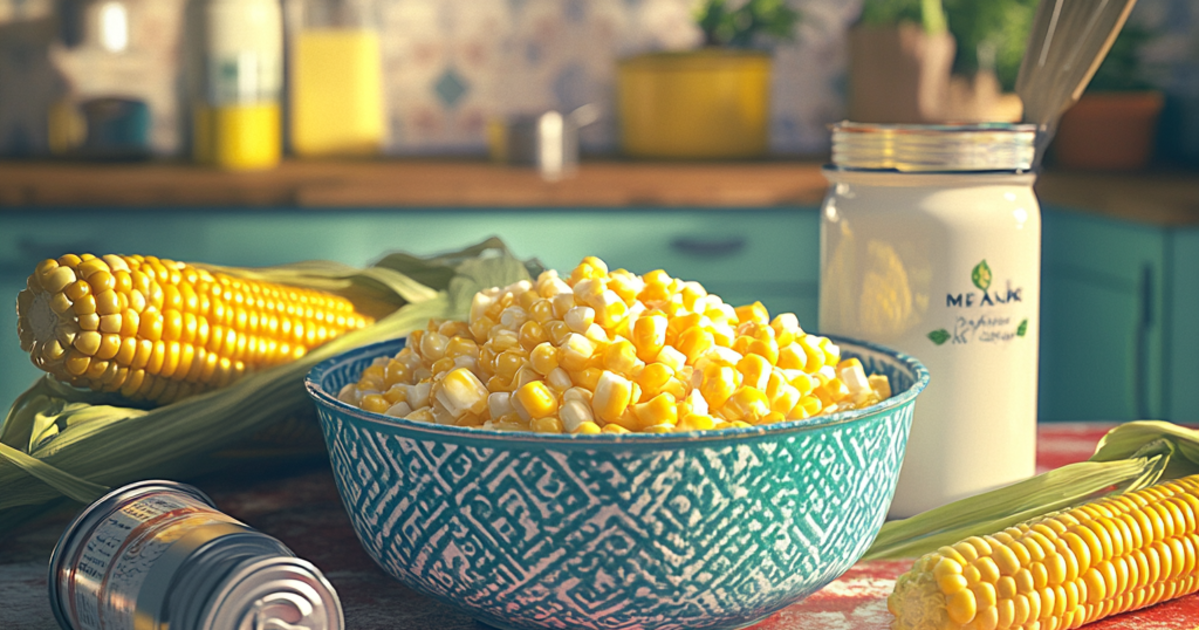Introduction to Substituting Canned Corn for Creamed Corn
Canned corn and creamed corn are common kitchen staples, but they have distinct uses. Canned corn contains whole, preserved kernels that provide texture in dishes. In contrast, creamed corn has a smoother consistency, achieved by blending pureed corn with a creamy liquid, which may include natural starches or added dairy.
Creamed corn is frequently used in soups, casseroles, and even in baked goods like cornbread, thanks to its rich consistency. Canned corn, on the other hand, is often used as a simple side dish or tossed into salads and stir-fries.
So, why do people ask if you can swap one for the other? Well, sometimes you’re in a pinch or you want to make a dish a bit lighter by using less cream. But before you start swapping one for the other, it’s important to understand the key differences and how they affect your recipes.
Understanding the Difference Between Canned Corn and Creamed Corn
To figure out if you can successfully substitute canned corn for creamed corn, it’s essential to understand how they’re made and what makes them unique.
Canned corn is simply corn kernels that are picked, cooked, and canned with water and sometimes salt. They’re preserved in their whole form, retaining their texture and natural sweetness. The liquid inside the can isn’t creamy—it’s just water that helps keep the kernels fresh. This makes canned corn a versatile ingredient for many dishes, but it doesn’t have the same richness as creamed corn.
Creamed corn is made by blending whole or pureed corn kernels with a creamy liquid. This liquid can come from the natural starches in the corn or added dairy. The result is a velvety texture with a slightly sweet flavor. It’s thicker, smoother, and richer than canned corn, making it perfect for binding ingredients in casseroles and soups.
Nutritionally, canned and creamed corn are quite similar in calories and nutrients. However, creamed corn often contains more sugar and fat, depending on the brand. For a healthier option, canned corn might seem better. Still, the texture and flavor differences could make substitutions tricky in some recipes.

Why Substituting Canned Corn for Creamed Corn May Not Always Work
Although canned corn can be used in place of creamed corn in some recipes, there are important factors to consider. One of the biggest challenges is the difference in consistency and texture. Canned corn is made up of whole, intact kernels, while the other one has a smoother, more liquid texture. This difference can drastically alter the outcome of a dish, especially in recipes where the creamy consistency of creamed corn is key to the overall texture.
For example, if you’re making a corn casserole, using canned corn without any adjustments might make the dish too dry. The lack of creaminess could cause the other ingredients to separate rather than come together in a cohesive, creamy mixture. To fix this, you would need to add extra liquid, such as milk or cream, and possibly puree some of the canned corn to mimic the smoothness of creamed corn.
Similarly, in soups, creamed corn adds both thickness and depth. Substituting canned corn could result in a thinner broth unless you thicken it with cornstarch or flour. The flavor might also differ. Canned corn is usually less sweet and creamy than creamed corn, so you may need to tweak the seasonings. Adding a small amount of sugar or a splash of cream can help balance the flavors and mimic the richness of creamed corn.
In short, swapping canned corn for creamed corn isn’t always a straightforward substitution. You may need to tweak the recipe by adding other ingredients to compensate for the differences in consistency and flavor.
When You Can Use Canned Corn Instead of Creamed Corn
Canned corn isn’t always a direct substitute for creamed corn, but it can work well in certain recipes. In dishes like soups or casseroles, where the binding properties of creamed corn aren’t essential, canned corn makes a practical alternative. To replicate the creamy consistency, you can blend a portion of the canned corn kernels with milk or cream. This creates a texture that mimics creamed corn while maintaining its flavor profile. For added thickness, puree the kernels until smooth and adjust the liquid amount to suit your recipe’s needs.
For lighter, non-dairy recipes, using canned corn instead of creamed corn can actually be an advantage. You get the corn flavor without the added fat or dairy, making it a great option for those who are lactose intolerant or simply looking to cut back on calories.
Soup recipes or casseroles that call for a lot of ingredients can still taste delicious with canned corn, especially if you’re mindful of adding extra liquid and flavor enhancements like garlic, butter, or onion to round out the dish.

How to Make Canned Corn Creamy for Substitution
If you’re aiming to substitute canned corn for creamed corn, the key challenge is replicating that smooth, creamy texture. Luckily, with a few simple techniques, you can turn your canned corn into a decent stand-in for creamed corn. One of the easiest methods is to puree a portion of the corn. By blending or processing some of the kernels, you break them down into a more liquid consistency, similar to that of creamed corn.
Start by draining the canned corn, then place about half of the kernels into a blender or food processor. Add a small amount of milk or cream to help smooth out the texture and give it the rich consistency that creamed corn typically has. If you’re aiming for a dairy-free option, you can use alternatives like almond milk or coconut milk.
Blend the corn until it reaches a smooth, slightly chunky consistency. If the mixture is too thick, feel free to add more liquid in small amounts until it resembles creamed corn. The rest of the whole kernels can be added afterward for a bit of texture, giving you that balance of smooth and chunky that many dishes require.
In short, blending and adding liquid will help you recreate that creamed texture and make canned corn a usable substitute in many recipes. With just a blender and some simple ingredients, you can transform canned corn into a viable alternative.
Step-by-Step: How to Modify Canned Corn for Different Recipes
Different recipes call for different textures and levels of creaminess, so modifying canned corn to fit these requirements is important. Here’s a step-by-step breakdown for adjusting canned corn depending on the type of dish you’re preparing.
For Soups:
If you’re making soups or chowders, canned corn can work quite well as a substitute for creamed corn. To replicate the thickness of creamed corn in a soup, consider adding a broth or cream base to boost the creaminess. You could also make a roux (a mixture of butter and flour) to thicken the soup. Once the base is prepared, blend some of the corn, as mentioned earlier, and mix it into the soup for a creamy texture.
For Casseroles:
In casseroles, where creamed corn helps bind the ingredients together, you’ll need a thickening agent. One trick is to add a small amount of flour, cornstarch, or even cream cheese to the canned corn mixture. These will help thicken the casserole and provide the smooth consistency you’d expect from creamed corn. Another option is to use heavy cream or a dairy-free substitute like coconut milk to add richness.
Baking Applications (Cornbread, etc.):
When baking, such as making cornbread or other baked goods, it’s important to maintain the balance of moisture and sweetness that creamed corn provides. To adjust canned corn, blend about half of the kernels as you would for other recipes, then stir in sugar or honey for a touch of sweetness. If the recipe leans toward the savory side, adding a bit of butter or sour cream will help retain the moist, tender texture while also giving the dish more depth.
In all cases, you can adjust the liquid levels and seasonings based on the recipe you’re working with. Whether it’s a thick casserole, a creamy soup, or a soft, moist cornbread, modifying canned corn to meet the dish’s needs is achievable with the right approach.
Using Additional Ingredients to Improve the Substitution
While canned corn on its own can be modified to resemble creamed corn, using additional ingredients can really elevate the substitution and make it even more successful.
For Creaminess:
Adding ingredients like butter, heavy cream, or sour cream can dramatically increase the creaminess of canned corn. These fats help to enrich the flavor and smooth out the texture, bringing it closer to the real thing. Heavy cream will add the most richness, but sour cream or even Greek yogurt can provide a nice tangy balance, perfect for savory dishes.
For Flavor Enhancements:
If you’re worried about missing out on the more intense flavor that creamed corn offers, try incorporating onions, garlic, or cheese into your dish. These ingredients can help round out the flavor profile, giving your recipe more complexity. Cheddar or Parmesan cheese can be great additions for casseroles, while garlic and onion work well in soups and chowders.
With these ingredients, you can ensure your dish doesn’t feel flat or lack flavor, even when you’re using canned corn instead of creamed corn. Plus, using flavorful additions like these can help disguise any differences in texture or creaminess that might be noticeable.
Common Recipe Types Where Substitutions Work Well
Substituting canned corn for creamed corn works best in certain types of recipes where a little extra modification won’t hurt. Some of the best recipe types for this substitution include:
Soups and Chowders:
In these dishes, creamed corn is often used for thickness and creaminess, which can be replicated with pureed canned corn.
Casseroles and Gratins:
In casseroles, you can easily add extra liquid and use thickening agents to recreate the creamy binding effect of creamed corn.
Cornbread and Baked Goods:
For baked goods, modifying the sweetness and moisture with sugar and butter makes canned corn a good alternative to creamed corn.

Best Practices for Substituting Canned Corn for Creamed Corn
When substituting canned corn for creamed corn, following some best practices can ensure your dish turns out delicious and close to the original recipe.
Choosing the Right Brand of Canned Corn:
Not all canned corn is created equal! Some brands offer sweeter kernels, while others might be more watery. If possible, go for a canned corn brand that has a good balance of flavor and texture. Look for labels that say “sweet corn” or “no added salt” if you’re mindful of sodium levels.
This guide of Best Canned Corn Brands for Cooking offers more details on how to choose the right brand.
Whether to Drain or Not to Drain:
One common question is whether to drain the canned corn. This depends on the recipe. For recipes that call for a thicker, creamier texture, it’s best to drain the corn. However, if you need more liquid in your dish (like for a soup), you might want to reserve some of the liquid and use it as part of the recipe to enhance the flavor.
Best Tools for Pureeing and Blending:
The right tools can make all the difference. A blender or food processor works well for creating that creamy consistency when pureeing the corn. If you don’t have either, a hand immersion blender can also do the trick. Just be careful not to over-blend—you still want some chunks of corn for texture.
Can I Use Frozen Corn Instead of Creamed Corn?
Frozen corn is another pantry staple, and like canned corn, it can be used in place of creamed corn with a few adjustments.
How Frozen Corn Compares to Canned Corn and Creamed Corn:
Frozen corn retains its texture better than canned corn because it’s typically flash-frozen shortly after harvesting. This means the kernels are firm and crisp once thawed, but they lack the creamy consistency needed to mimic creamed corn.
Adjustments Needed if Using Frozen Corn:
If you opt for frozen corn, you’ll need to first thaw the corn completely before using it. Then, follow the same method for pureeing some of the kernels and adding a creamy liquid (like milk or cream) to achieve a texture similar to creamed corn. Adding extra seasonings like butter or onion powder can help enhance the flavor, too.
What About Fresh Corn as a Substitute?
Using fresh corn as a substitute for creamed corn can be a fantastic option, especially when corn is in season.
When Fresh Corn Can Be Used:
Fresh corn is ideal for summer recipes when the produce is at its peak sweetness. However, like frozen corn, fresh corn lacks the creamy texture of creamed corn and needs to be processed to achieve a similar consistency.
How to Prepare Fresh Corn for Substitution:
To substitute fresh corn, you’ll first need to shuck the corn and remove the kernels from the cob. Boil the kernels until tender, then blend a portion of them with a creamy liquid to replicate the texture of creamed corn. Adding a touch of butter or olive oil will help round out the flavor and smoothness.
Variations in Recipes When Using Canned Corn
When substituting canned corn for creamed corn, you’ll find that adjustments can vary depending on the recipe, cuisine, or dietary preferences.
How Substitutions May Differ Across Cultures or Cuisines:
In Southern-style dishes, creamed corn is often used for its rich and savory flavor, but in other cuisines, such as Mexican or Asian recipes, canned corn may be more suitable, especially when looking for a lighter, crunchier element. These cultural variations can affect the substitution process, so it’s important to tailor your methods to the dish you’re preparing.
Sweet Versus Savory Dishes:
When using canned corn, you can easily switch between sweet and savory recipes. For savory dishes, adding herbs and spices like garlic or cumin works well. For sweet applications, such as corn pudding or cornbread, mixing in sugar or honey will help mimic the sweetness that creamed corn typically adds.
Using Canned Corn in Vegetarian or Vegan Recipes:
Canned corn is naturally vegetarian and can easily be adapted to vegan recipes by substituting dairy-free alternatives like coconut milk or almond milk for any creamy ingredients. This makes canned corn a versatile and easy ingredient for plant-based dishes.
FAQ Section: Substituting Canned Corn for Creamed Corn
Can you blend canned corn to make creamed corn?
Yes, you can! By blending or pureeing a portion of canned corn and mixing it with milk, cream, or a dairy-free alternative, you can create a creamy texture similar to creamed corn. This method works well in many recipes that call for creamed corn.
What can I use if I don’t have creamed corn?
If you don’t have creamed corn, you can substitute canned corn by blending some of the kernels and adding a thickening agent like flour or cornstarch. Additionally, incorporating ingredients like butter or heavy cream can help mimic the rich consistency of creamed corn.
How do I thicken canned corn to replace creamed corn?
To thicken canned corn, you can add a roux made from butter and flour, or stir in a bit of cornstarch. Pureeing part of the corn and mixing in cream or milk will also help achieve the right consistency for recipes like soups or casseroles.
Can you substitute canned corn for creamed corn in cornbread?
Yes, you can substitute canned corn in cornbread recipes by pureeing part of the corn and adding it to the batter. You may also want to add a bit of sugar or honey for sweetness, and some milk or sour cream to keep the cornbread moist.
How does the flavor of canned corn compare to creamed corn?
Canned corn is generally sweeter and less rich than creamed corn, which has a creamier, more savory profile. The flavor of canned corn is fresher and crunchier, while creamed corn tends to have a smoother, slightly more buttery taste.
Can I use canned cream-style corn instead of canned corn?
Yes, you can use canned cream-style corn in place of regular canned corn, though it will result in a creamier, less textured dish. For recipes requiring whole kernels, it’s better to stick with canned corn unless the creaminess is desired.
Conclusion: Final Thoughts on Using Canned Corn Instead of Creamed Corn
In summary, canned corn and creamed corn differ in texture and flavor but can often be substituted with some creativity. By blending canned corn or adding milk and butter, you can achieve a creamier consistency. These techniques make it easy to adapt recipes that traditionally call for creamed corn. This substitution works well in soups, casseroles, or even cornbread.
Don’t hesitate to experiment in the kitchen—every recipe is a chance to be creative. With some flexibility, you can turn this simple substitution into a versatile solution. It opens up new possibilities for flavors and textures in countless dishes.

